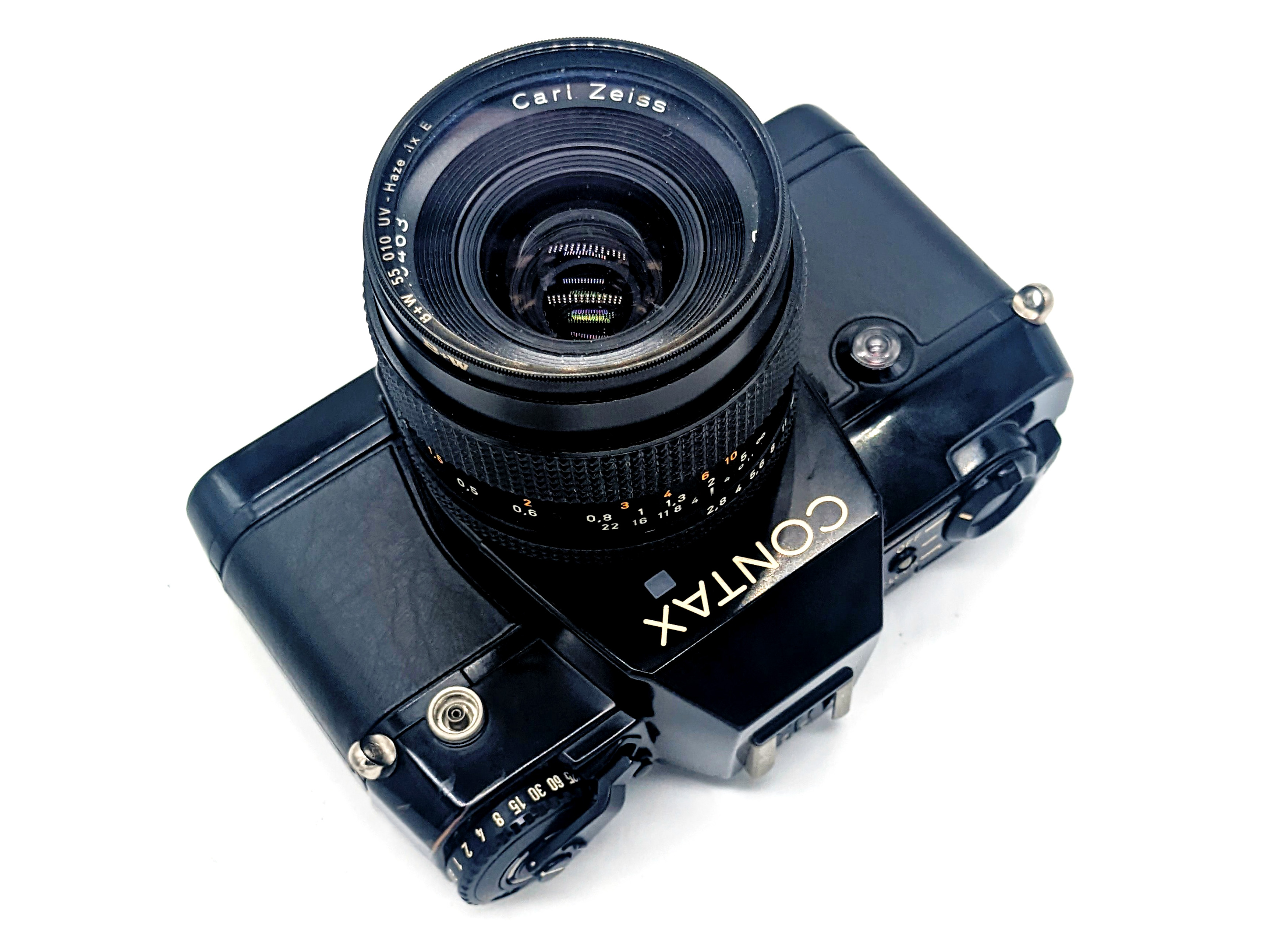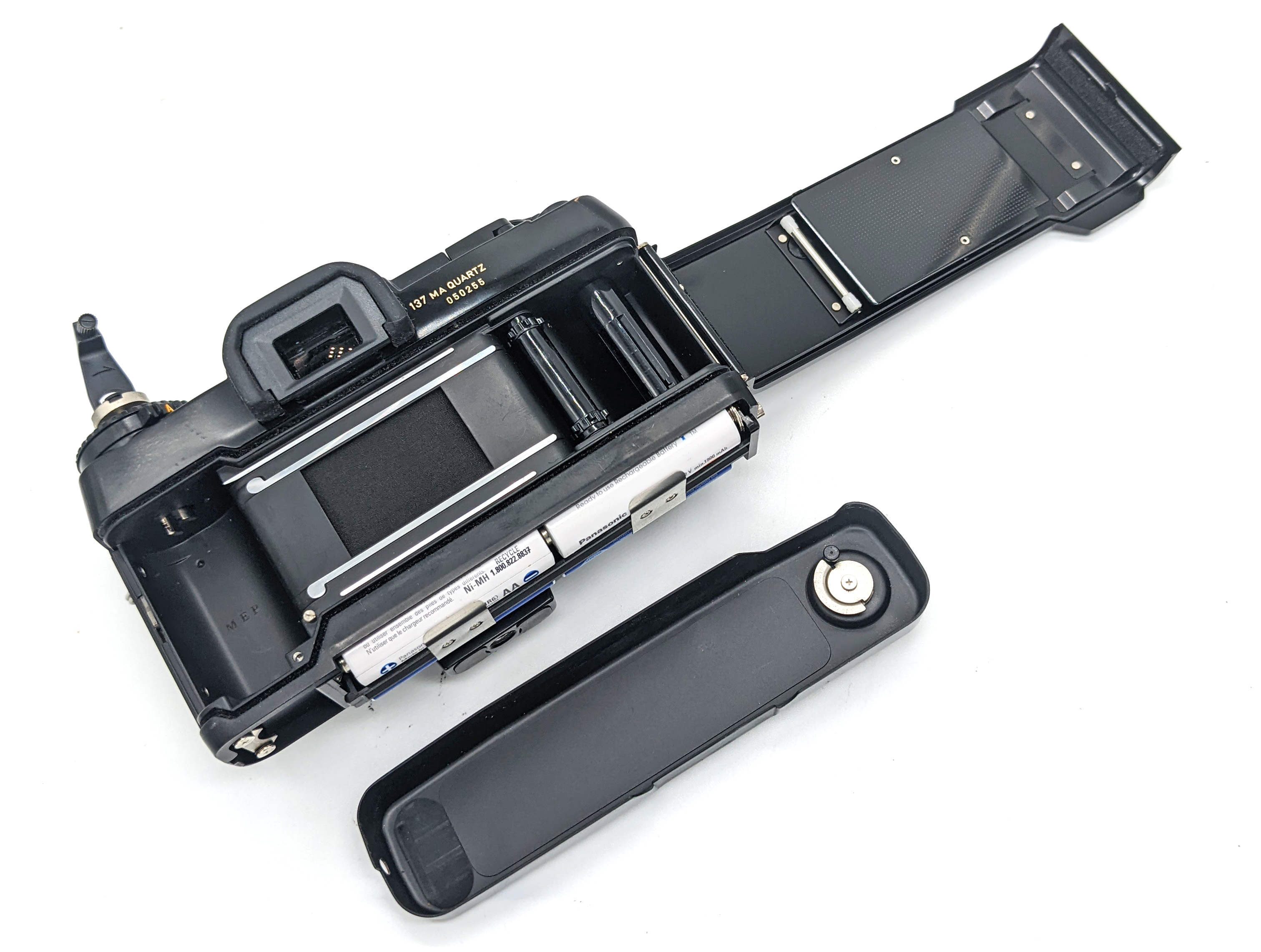
During 1982, the Zeiss-Yashica partnership announced two new cameras: the Contax RTS II, its new professional flagship and the 137 MA, an upgraded version of the 137 MD. The 137 MA went on sale in North America during the spring of 1983. While retaining most of the same specifications as the MD, the MA included the following upgrades: (1) optional manual shutter speed control; (2) a faster integrated motor drive to 3 frames per second from 2; and (3) an improved the film transport system. At launch, camera shops often bundled the 137 MA with either the Contax 45mm f/2.8 AE Tessar (meh) or the 50mm f/1.7 AE Planar (excellent). According to advertised retail prices at the time, the 137 MA cost about $100-150 more than the Contax 139Q. The 137 MA was produced until about 1986, replaced that year by the Contax 167MT.
At bottom, the 137 MD/MA, the 139, and and Yashica FX-D have similar capabilities: (1) the same viewfinder coverage and magnification; (2) the same top shutter speed of 1/1000; (3) aperture-priority autoexposure; (4) either an internal or optional external motor drive; (5) the same or similar metering system; (6) provisions for exposure compensation; and (7) an exposure lock function. Over the FX-D, the 139 and 137 have brighter viewfinders, longer max auto shutter speeds (11 seconds versus 1 second), TTL flash capability, and display the selected aperture in the viewfinder. The 1985 Kyocera-produced Contax 159MM (the successor to the 139) and Yashica FX-103 (the successor to the FX-D) contained significant further improvements. The 159MM would add, inter alia, a top shutter speed of 1/4000; and both it and FX-103 would add program-mode autoexposure. However, the launch of the 159MM and FX-103 clearly signaled Kyocera’s intentions to push Contax upmarket and Yashica downmarket.
These days, the 139 and 137 MA remain generally inexpensive on the used market, while many sellers cannot give FX-Ds away. Although the 137 MA is quirky, its controls are all in the wrong places, and it is bulkier and heavier than many of its contemporaries, I think it is a fantastic and reasonably-priced vintage SLR. Let’s take a look.
Specifications
| Year Announced | 1982 |
| Lens Mount | Contax/Yashica Bayonet |
| Viewfinder Coverage | 95% / 0.86x |
| Focusing Screen | 90-Degree Split Screen; Microprism Collar |
| Viewfinder Info | Shutter Speed, Aperture & Exposure Count |
| ASA Range | 12-3200 |
| Shutter | Electronic Horizontal Cloth Focal Plane |
| Shutter Speeds | 11 sec. – 1/1000 |
| Flash Sync | 1/60 |
| TTL Flash? | With Dedicated Contax Units |
| Exposure Compensation | + / – 2 Stops |
| Exposure Lock | Yes; Switch on Top |
| Automatic Film Advance | Single; Continuous Up to 3 FPS |
| Batteries | 4 x AA |
| Weight | 665g (without batteries) |

Operation
Viewfinder: The 137 MA’s bright viewfinder is one of its primary strengths. The 95% coverage and 0.86x magnification, the same as the 139 and FX-D, is pretty good, but not professionally-good. The non-interchangeable focusing screen is a standard 90-degree split screen with a microprism collar. The viewfinder displays the shutter speed (via LEDs) on the right of the frame, the selected aperture at the top of the frame, and the current frame count on the left of the frame. The 139 does not display the film count. The FX-D does not display either the aperture or the film count.
Autoexposure: The 137 MA utilizes aperture-priority autoexposure, via the “A” position on the shutter speed dial. The top shutter speed of 1/1000 was standard for this class of camera. While it is nice that the 137 MA has the capability to manually select the shutter speeds, it is a little awkward to use in real life given the left-hand side controls and the fact that the shutter speeds are displayed on the side of the dial and not on top. To use the 137 MA in a manual metering mode, the LED in the viewfinder will blink at the selected aperture, but will remain on at the appropriate shutter speed given the aperture. The horizontal cloth focal plane shutter on the 137 MA is an unusual attribute for a 1980s Contax camera, not used since the 1975 RTS or on any camera after, but it probably has something to do with keeping the shutter noise down and/or better syncing with the motor drive.
Film Loading / Advance: The automatic film loading on the 137 MA is still quite primitive compared with the next generation of SLRs. The film must be pulled across into the slot like a normal manual camera. Once it is in the slot, you press the shutter button which in theory should automatically spool the film onto the sprockets. The continuous mode allows shooting up to 3 frames per second, which was extraordinary for 1982. The integrated film advance is actually fairly muffled, making at kind of shew shew sound, much quieter than any external motor drive of the era. Rewinding of the film is through a regular rewind crank (auto rewind technology was still in the near future). My example seems to have a “hair trigger,” which means if you are not super careful, it is really easy to shoot two consecutive frames in “Single” mode.
Exposure Lock: It would be fair to say that Contax never took a conventional approach to exposure lock. Instead of a switch on the front of the camera like the 139 and FX-D, the 137 MA uses a switch at the top right side of the camera. The procedure is to meter the scene, switch the setting to “AE Lock,” and the camera will lock the prior shutter speed as long as the switch is on that setting. To disengage, you must switch off the AE Lock setting.
Batteries: The 137 MA is powered by four AA batteries loaded in the bottom of the camera. Easy, cheap, and convenient.
Flashes: The 137 MA can use the world of Contax-branded TTL flashes. The flash sync speed is slightly slower at 1/60 than the 1/100 for the other products. When using a Contax TTL flash, the camera will automatically set the shutter speed to 1/60 when in “A” mode. For all other flashes, the shutter speed dial must be turned to “X.”
Other Features: The 137 MA also has the slew of other common features, like a self-timer, a battery check, exposure compensation, and a depth-of-field preview.
Accessories: The 137 MA had a few accessories, like a nifty hand grip and a primitive, useless databack. As OEM eyecups are hard to find, like nearly every Contax and Yashica product, the cheap replacements that work for many Canon digital cameras fit perfectly on the 137 MA.

Conclusion
The 137 MA represents a pinnacle of the pre-Kyocera-takeover Contax-Yashica advanced amateur line. It is a high-quality (yet somewhat hefty) camera with a bright focusing view and a relatively muted automatic advance. As a platform for C/Y lenses, it will not disappoint. If considering acquiring a pre-1985 Contax SLR, I would still recommend the RTS II overall as it has a higher top shutter speed and a professionally-bright viewfinder, but the 137 MA is certainly not far behind. While the 137 MA cannot really compete with the 167MT and later Contax cameras in terms of overall functionality, it does provide pretty much everything you would need in a non-professional manual-focus SLR.
I bought a 139 from new in 1982, my first good camera. I totally loved it, it felt like the future. I still have it today although it hasn’t worked for many years and is in a very sorry state. About 1983 I also acquired a used 137MD. That was a really lovely camera, the autowind was very luxurious, and I didn’t miss manual exposure which I thought was usually a pointless waste of time. Still think that actually. I sold the 137 after a year to make way for a Leica R4 that came into my possession. I always kind of missed the 137 though.
I still own a 137MA which I bought while living in Tokyo in about 1983 to replace a 139. As I got older the whole outfit became too heavy to lug around on holidays, and I now mostly use a micro 4/3 Lumix. However, the 137 still gets a run every so often. It has never let me down, and when I recently had it serviced the shutter speeds and metering were still within 5%. I haven’t used it with the TLA30 flash for a while, but I’m pretty sure I have used it for TTL daylight fill in flash in the past. Will have to check that. Like all Contaxes of that era the body and ergonomics were by Porsche Design, and once you get used to the unusual control placement it actually works much better for right handers than the traditional layout. Overall it was in its day a much better camera than things like the Nikon FE or Canon AE1, and it is still a pleasure to use even now.